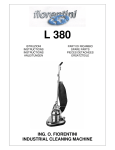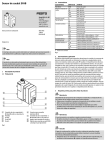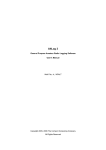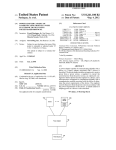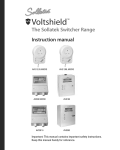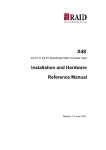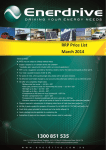Download "service manual"
Transcript
Triumph TR7 GM Saturn / Bosch Alternator Upgrade Greg Bober, Copyright 7 Sept 2008, Rev 1.2 (originally written 4 Sept 2005) The following information is presented as "public knowledge" and is only for the personal use of individuals who are either restoring or repairing their own Triumph TR7 vehicle. The information may not be used commercially without the consent of Greg Bober (the author), who can be contacted via [email protected]. Triumph car clubs can reprint this as a monthly newsletter article, but please email [email protected] so I know where in the world this has being reprinted. Thanks. Abstract After 25 Years and 101,000 miles, something in my TR7’s alternator broke. It was no longer providing any output current. Its possible that one or two or more diodes in the alternator’s rectifier had become non-conductive. Locally its getting hard to find parts service for older British cars (some auto parts stores don't even recognize that Triumph was a company that made cars...just like Nash). At this time, I planned on driving and putting my TR7 on display at the Detroit Triumph Sports Cars and Motor Cycle Show, the car show was 7 days away. Obtaining a replacement alternator or replacement parts from another state, or the UK would mean that my TR7 would miss the 2005 car show. The circumstances forced me to locate a suitable, equivalent replacement for the Lucas 25ACR alternator. This document describes how a person with a limited skill in auto repair can replace their original Lucas 25ACR 65 Amp alternator with a newer 96 Amp alternator from Bosch (the same alternator supplied to GM’s Saturn product line). The higher current output at low engine RPMs from the Bosch alternator will prevent the TR7’s interior and exterior lights from dimming and getting brighter as the engine goes into idle or as the RPMs increase from idle. Another Reason for Upgrading To A Higher Current Alternator Later after replacing the alternator I added up all the electrical current loads on my particular TR7, and I wasn’t surprised the original Lucas alternator became defective. If the original alternator was capable of 65 Amps of current continuously, I was using the alternator close to or beyond its specifications. By adding up the electrical current demands on my vehicle, the newer 96 Amp alternator supports my vehicle’s needs much better. During day time operation, if I just take a reasonable guesses at my car’s typical electrical current demand, my TR7 typically wants about 23Amps from the alternator. electric radiator fan = 12A (intermittent duty) radio/CD Player about 2A EFI + fuel pump = 15A (10A are mS duration pulsing injectors), 7Amps average Ignition = 6A (pulsing), about 2 Amps time average battery recharging = variable amount At night, add in 40 Amps to 47 Amps more: Head Lamps = 10A (55W each on low beam), day time use in some countries Hi Beams = 17A (intermittent duty) side, trim and dashboard lamps = 15A fog or driving lamps = 15A Add in another 15 Amps to support intermittently used vehicle features: Windscreen Wipers = 10A (intermittent duty) A/C clutch = 5A (intermittent duty) interior blower = 10A (not used too often is a Drop Head Coupe) brake lamps = 6A (intermittent duty) turn indicators = 5A (intermittent duty) If everything is activated at the same time, all of these add up to a worst case demand of about 110Amps. Such a worst case condition doesn’t happen often, but it is possible and not continuous. Should such a condition occur, the alternator will be able to supply 87% of the vehicle’s needs. The remaining 13% power demand will be sourced from the car’s battery. Prior to the installation of the higher current alternator, the Lucas 25ACR alternator covered only 60% of the maximum demand, and during my typical night time operation, the Lucas 25ACR was often operating at 100% of its capacity with no reserve capability support “intermittent duty” vehicle functions. This is 1 reason why my interior and exterior lamps would “dim” when the engine idled and I pressed the brake pedal. Read this First Read all instructions before starting the repair procedure. Tools Required: • screwdrivers • pliers • “C” Clamp • wire cutters • wire strippers • wire / connector crimping tool • 10mm socket wrench • 12.5mm or ½” socket wrench and wrench Replacement or Upgrade Components Required The components are available from common Auto Parts in the United States and from internet auto parts web sites. Some can even be obtained from junk / scrap yards. • GM Delco-Remey #8215 Alternator used on US/Canada GM Saturn “L” Cars with a 1.9L “gas” engine from 1991 to 1996 (some auto parts web sites indicate 1991 to 2002 Model Years) See Appendix A for a listing of other equivalent part numbers for this alternator. The #8215 Alternator is actually a Bosch unit, and is available from many auto parts stores and internet auto parts suppliers. The #8215 Alternator is a little smaller than the Lucas 25ACR alternator, but it fits into the TR7 without having to make a bracket or need for any special tools. I purchased mine as a “rebuilt” alternator $100 from George’s Auto Parts in St. Clair Shores, MI (it looked clean and new out of the box). For price comparison: A local Saturn dealer wanted $150 for a “new” alternator. A local car scrap/salvage yard wanted sell this alternator for $35, but it was in a “dirty”, “used” and untested condition Be warned, if you are going to salvage a Saturn car your self, the alternator is located on the under side of the engine against the passenger side cowl panel and near the exhaust manifold, a rather in accessible location without a car hoist. (PS. Automotive people don’t call it the “firewall” anymore since it really can’t prevent a fire from penetrating into the passenger compartment. Thus those in the automotive industry they prefer to call that particular piece of sheet metal the “cowl” panel.) • 2 ½” diameter “V” belt pulley with a 0.67” shaft hole from a Ford Motor Craft alternator At my local AutoZone store, I was given one of these pulleys for free from a smashed, returned alternator “core”. These pulleys were used on almost all Ford US & Canadian vehicles from 1975 to about 1990. No part number is available. A Ford pulley isn’t mandatory. But you’ll definitely need a 2.5” to 3.6” diameter pulley with a 0.67” shaft hole, so there is flexibility in what can be used (see Appendix B). The Lucas alternator’s pulley can not be reused, because its shaft will not fit properly on the Bosch alternator’s shaft. • #85854 Alternator pig tail harness, $7 from AutoZone (East Pointe, MI) This same pig tail harness from a Saturn dealer was quoted at $43. • • sleeved male ¼” wide spade terminal connector male and female sleeved barrel terminal connector I wanted these connectors to be different to avoid any chance of misconnection and be sleeved with a protective coating to avoid touching any metal surface which would cause a short circuit. Alternator Removal From Vehicle Reference: TR7 Service Manual page 389, Procedure 86.10.02 Safety First Before starting, disconnect the car’s battery + terminal, and fold it under the battery tray to insure an electrical connection or short is not accidentally made during the vehicle’s servicing. These instructions are unique relative to my EFI type TR7, but would be similar for the carbureted version of the TR7. These instructions have been re-sequenced from the original discussion room‘s posting. 1. Remove the air by-pass hose that connects from the by-pass valve located almost above the alternator, and hose from the intake plenum to the top of the charcoal canister. Fold these hoses back and out of the way. 2. Remove upper adjustment bracket bolt supporting the top mounting ear of the alternator. 3. Disconnect electrical connections from the rear of the existing Lucas alternator. 4. Disconnect the lower mounting bolt thru the Lucas alternator's lower mounting holes. When removing this lower bolt, be prepared hold the 10 Lbs. alternator. 5. Loosen and fold up the upper mounting bracket out of the way and as far back as possible. 6. Lift and remove the old Lucas alternator from the engine compartment. (See Picture 1.) Picture 1: Old alternator removed from engine mounting brackets. 7. On the #85854 pig tail harness, cut & remove black wire. It is not needed. Cut it at the base of the connector so that nothing can accidentally short against this particular wire. 8. Cut the red and brown wires 3 inches or 75mm long (See Picture 2 and 3). 9. Crimp a barrel shaped terminal on the Bown pig tail harnesses wire. 10. Crimp a mating barrel shaped connector on the Brown/Yellow wire in the TR7 that used to connect to the rear of the Lucas alternator. 11. Crimp a sleeved, male spade terminal connector on the Red wire of the pig tail harness. 12. The pig tail harness should appear as shown in Picture 3. 13. Remove the modern 5 groove belt pulley from Bosch #8215 alternator, replace it with the 2.5" or 2.5” to 3.6” diameter “V” belt type pulley from another alternator. An auto parts store or alternator refurbishing shop can assist you in accomplishing this task. 14. With a clamp, squeeze the mounting insert on the Bosch #8215 alternator deeper into its mounting hole as deep as possible, the extra 1mm is all my new alternator needed to fit the alternator into my TR7. Depending upon fit in your vehicle, this may not be required. (See Picture 4.) 15. Plug the little harness made in Steps 7 through 12 into the socket located in the back of the Bosch #8215 alternator. (See Picture 5.) maintain existing Large Brown #6G TR7 Battery Cable and eyelet B + back of Bosch #8215 alternator existing TR7 small #18G Brown wire and with male spade terminal trim Red wire to 3” or 75mm length cut black wire against the #85854 connector existing TR7 Brown/Yellow #18G wire, crimp on a matching set of connectors for these wires trim Brown wire to 3” or 75mm length Picture 2: Bosch #8215 Alternator to TR7 wiring diagram through the #85854 pig tail harness. Picture 3: The #85854 Pigtail harness Black wire removed & connectors crimped on Red & Brown wires. Mating wiring harness barrel shaped connector is shown on the right. Picture 4: Pushing the Bosch #8215 Alternator’s mounting insert deeper into its hole. Picture 5: Alternator with the pig tail harness installed. Picture 6: New Alternator electrically installed. Reference: TR7 Service Manual page 389, Re-Fit 86.10.02 and belt tensioning 86.10.05 procedures. 16. Install the long bolt through the lower alternator mounts first to support the alternator’s weight. 17. Install the high current, big Brown battery wire in the TR7 to the B+ stud bolt on the back of the #8215 alternator. (See also Picture 2.) 18. Connect the #85854 pig tail harness’s Red wire to the TR7’s small Brown wire via their mating connectors. 19. Connect the pig tail harness’s Brown wire to the TR7’s small Brown/Yellow wire via their mating connectors. 20. Install the upper mounting bracket bolt through the bracket and then through the alternator’s upper mounting ear. Lightly finger tighten. Do not completely tighten this bolt. 21. Install the alternator belt around the pulley. 22. Pull the alternator away from the engine to increase tension on the belt and then completely tightened the upper mounting bracket bolt. Then tighten the lower alternator mounting bolt. (See Picture 6.) 23. Re-install the charcoal canister and air-by-pass hoses disconnected in Step #1. 24. Reconnect the battery cable connection(s) at the battery’s + terminal. Testing the New Alternator • Start the vehicle, and measure the voltage applied to the battery with little electrical loading (headlamps and all other vehicle features OFF). The #8215 alternator on my vehicle was applying 14.7V across the battery’s terminals. • Check the instrument panel’s “Volts” gauge, the meter’s pointer should be located near the maximum “normal” or white zone demarcation (see Picture 7). Picture 7: TR7’s Voltage Meter, pointer location showing the Alternator is “charging” the battery. Done! Pat yourself on the back and go for a road trip. Other Reference Documentation 1. TR7 Service Manual, AKM3079B Published by BL Car Limited, 1981 2. http://www.forum.triumphtr7.com/topic.asp?TOPIC_ID=2023&SearchTerms=Saturn,Alternator 3. http://www.forum.triumphtr7.com/topic.asp?TOPIC_ID=6153 4. web site reference removed due to accuracy issues (Appendix A information) 5. Bosch – USA, Customer Service is the source for the AL8596 alternator technical data Biography Sorry can’t find a picture of me (I’m always holding the camera), so here’s my TR7. I’ve been a part of designing automotive electronics since joining Ford Motor Co. (North America) Automotive Components Division (now Visteon) in 1986. To my credit, I’ve designed the control electronics for many different suspension / steering control modules, body illumination modules, dash panel clocks, and multi gauge instrument clusters (examples are Thunderbird Super Coupe Shock and Steering module, Lincoln Mark 8 Shock Module, Jaguar XJC clock, Jaguar ‘S’ Class cluster, Lincoln LS cluster, Nissan Quest/Mercury Villager cluster, plus many more over 20+ years). From 2005 to 2008 I briefly worked at the Alternator/Wiper/Fuel Pump lab at the Ford/ACH/Visteon Rawsonville, MI plant and at the HVAC lab at the Sheldon Rd. plant. From 2002 to 2005 I restored the above California EFI type TR7 Spider using many methods of improvement applied to current production vehicles for electrical power distribution and fusing strategies. My TR7 now has reliability similar to a new car, I sometimes drive it to work (70 miles round trip). I now design and test Lithium Ion battery packs for the next generation electric / hybrid vehicles. Appendix A: Table of Equivalent Alternators According to a few auto parts interchange web sites, the alternators listed below are “equivalent” replacements. Be very careful, databases can’t always be trusted to be accurate, all of these alternator part numbers below have been identified as 8215 replacements or “equivalent”, but a few alternators have been found to be different by readers who were kind enough to email me their experiences. OEM PN(s) Manufacturer 8215, AES-8215 LESTER N8215 NEW TECH AL8596X, AL8596N, AL8657X (N = New, X = Remanufactured) BOSCH Many databases show different part numbers as “equivalent”. Without investigating each one individually, replacement compatibility and ease of installation isn’t known for the part numbers shown below in yellow. The key identification difference is that an 8215 has a 3 pin electrical connector. 186-6134, 1866134 BECK/ARNLEY 21021310Y, 21021447Y, 21022772, 21022893, 21022893Y, 21020854, 21023515, 21023702, 21024485, 21024726 (see red note below) GM 240-5215, 2405215, 240-5216, 2405216 PICTURE ID CATALOG A1842, A1842 LUCAS 20-1115-11-1, 105 Amp CS130 family (they look like 8215s, but have many small differences: mounting hole position and fit problems, shaft diameter is slightly too big for the Ford pulley, threaded holes, and have a 4 pin electrical connector) Not recommended for use, you will have installation difficulties (aka. hassles). front and back of the alternator The alternator can come with a splash shield. The use of the shield doesn’t matter for the TR7. Note: I’m not able to verify if USALT-1304B is a 105A version of the 8215 alternator. Appendix B: Other Relevant Calculations According to the technical information provided from Bosch, the alternator’s capable of a minimum of 18Amps @ 1800RPM and 96Amps @ 6000RPM at the alternator shaft. Thus with an alternator pulley diameter of 2 ½” and the engine’s alternator drive pulley diameter of 5 ¼”, then a typical cruising engine speed of 2857RPM or greater, will allow the alternator to provide 96Amps for recharging the TR7’s battery and supporting the vehicle’s electrical loads. (6000 RPM)*2.5”/5.25” = 2857 RPM The Bosch alternator’s lowest RPM for providing a regulated output voltage and current is with an alternator shaft speed of 1250 RPM. With an alternator pulley diameter of 2 ½” and engine alternator drive pulley diameter of 5 ¼”, the alternator can provide output current with an engine speed as low as 595 RPM. (1250 RPM)*2.5”/5.25” = 595 RPM Since the TR7 repair manual indicates 850 is lowest “idle” RPM, the minimum alternator shaft speed of 1250 RPM is always satisfied. At an engine speed of 857RPM, the Bosch alternator will be able to generate a minimum of 18Amps. (1800 RPM)*2.5”/5.25” = 857 RPM If a 2 ½” alternator pulley is not available, 3.6” is the largest alternator pulley diameter that could be used and have the alternator deliver some operating current at engine idle. (850 RPM / 1250 RPM)*5.25” = 3.6” The Bosch alternator’s highest allowed rotational speed is 13000RPM (a mechanical limit on the bearing and brushes). Again, with an alternator pulley diameter of 2 ½” and the engine’s alternator drive pulley diameter of 5 ¼”, the alternator can briefly tolerate an engine speed of 6190 RPM. (13000 RPM)*5.25”/2.5” = 6190 RPM I don’t run my engine up to 6100RPM, so this limit doesn’t matter to me. However, if you race and operate your engine often in the 5000 RPM to 7000RPM range, 2.9” is the smallest acceptable alternator pulley diameter. If you use a pulley smaller than 2.9”, you’ll risk having premature alternator bearing failure. (7000 RPM / 13000 RPM)*5.25” = 2.9” If your driving habits are like mine, general “Grand Touring” or non-racing, a 2 ½” alternator pulley is acceptable for use. However, if you race and drive at very high RPMs often, you’ll need to seek out a 2.9” to 3.6” pulley wheel to respect the Bosch alternator’s limits of operation and durability.

















